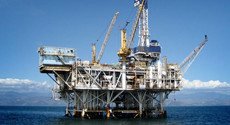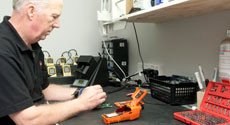Water purification and wastewater treatment are typical applications for our gas detection equipment within the central & local government sector…
On this page
- Gas detection in water & wastewater treatment
- FAQs (scroll down)
- Case studies (scroll down)
- Testimonials (scroll down)
Gas detection in water & wastewater treatment
Water purification and wastewater treatment processes involve a number of combustible and toxic gas hazards, which must be continuously monitored.
Toxic gases can also build up in confined spaces, depleting oxygen and making the space extremely dangerous for people operating and monitoring the plant.
Our fixed gas detection equipment and portable gas detectors are perfect for monitoring water treatment systems. They’re designed for all safety needs in unclassified areas, so they’re resistant to corrosion and very durable in harsh environments.
Specific applications
- Collection storm water & wastewater
- Water treatment
- Wastewater treatment
- Discharge
- Transmission and distribution
- Confined space entry
- Data-logging/industrial hygiene – workplace exposures
- Environmental
- Fixed point
Potential hazards
- Ammonia
- Carbon monoxide
- Chlorine
- Chlorine dioxide
- Hydrogen chloride
- Hydrogen cyanide
- Hydrogen sulphide
- Nitric oxide
- Ozone
- Sulphur dioxide
- Volatile organic compounds
- Toxic gases
- Oxygen deficiency/enrichment
Entec provides a wide range of fixed gas detection systems and portable gas detectors for water purification and wastewater treatment to help keep employees safe and production running.
Find out more…
You can trust our expertise and rely on our service
We know your No. 1 priority is to protect your people and your plant. What you don’t want is to fail legal or OSH requirements, have a staff member harmed or be prosecuted for an accident. With an increasing focus on health and safety in the workplace, it’s more important than ever.
We understand the unique requirements of Central and Local Government. You don’t need the hassle and risk of gas detectors that are expensive, problematic, unreliable, prone to sensor failures, require too much servicing, or have recurring problems. We’ll provide you with gas detectors that are…
- Cost-effective.
- Serviced locally in our authorised service centre (the only one in NZ).
- Easy and reliable to manage on-site via function test / bump test stations.
- Backed up with our support and expertise – we’ll be there when you need us.
FAQs
How long do your gas detectors last?
Depending on how they’re used there’s no reason a high-end instrument shouldn’t last 6 years. With low-cost instruments ($1,000) you will reach a stage where the gas detector is still fine but the cost of keeping it in the field is greater than buying a new one. For example, replacing two sensors and calibrating the unit could cost $1,100 but a new instrument is around $1,000.
What sort of water ingress protection do your gas detectors have?
All our instruments are IP rated (ingress protection rated). Typically IP67, which is very high. Gas detectors rated to IP67 must be dust tight and withstand immersion in water up to 1 metre deep for 30 minutes.
Solid particle protection level 6: No ingress of dust; complete protection against contact.
Liquid ingress protection level 7: No ingress of water in harmful quantity when the unit is immersed in 1 metre of water for 30 minutes.
See https://en.wikipedia.org/wiki/IP_Code for more info.
What are my options with bump testing / calibration?
We can provide you with options from the top end to the basic. With our iNet InSite programme you get all the bells and whistles, all the basics like data-logging, bump testing and calibration; plus you get reports on instrument usage such as…
- Instrument in alarm condition and alarm ignored.
- Instrument turned off whist in alarm condition.
- iNet Control.
What is iNet Control?
iNet Control is a web-based application accessible from any PC web browser that allows you to configure and manage your gas detector fleet. It gives you practical insights into your gas detection program using trends, performance metrics and custom reports.
Can you calibrate our gas detectors for us?
Yes. Calibrations done by us at our premises cost $140 per instrument.
Are gas detectors intrinsically safe?
Yes. All our instruments are independently tested by authorities such as ATEX, IECEx, ANZEx, UL, CSA and many more, usually country dependant.
New Zealand recognises the first 3. The gas detector has a sticker attached to it referring to the certification authority and its rating. Many have more than one authority rating, often 3.
How much do gas detectors cost?
Depending on sensor configuration and the number of gas detectors being purchased, the price varies from $950 to $4,500. The MX4, our most popular instrument, sells for $950 to $1,150 depending on configuration.
What’s the turnaround for service?
We process 95% of instruments the day they arrive. It does depend a little on the volume of work but we strive for same day turnaround whenever possible.
Do your gas detectors detect toxic gases such as carbon monoxide (CO), nitric oxide (NO) and nitrogen dioxide (NO2)?
You would typically be looking at our MX4, MX6 and single gas models depending on the application, etc.
Do your gas detectors detect hydrogen sulphide (H2S)?
Yes. You would typically be looking at our MX4 model.
Do your gas detectors detect combustible gasses such as methane, hexane, pentane and ethane?
Yes. You would typically be looking at our MX4 model.
Can you train us in how to use the gas detectors?
Yes, most definitely. On delivery we like to spend time with the users taking them through the basic use of the gas detector. We also like to spend time with the users of the docking stations teaching them how to use them. Industrial Scientific also has very good online training modules.
Case study: Waste not want not
A wastewater plant required an instrument to monitor hydrogen sulphide (H2S), methane (CH4), oxygen (O) and carbon monoxide (CO) levels.
After a raft of research considering many products from different manufacturers they determined our Industrial Scientific instrument was the best value and purchased the MX4 model.
Testimonials
“It’s their whole trustworthiness. I was at a conference where a competitor of Entec approached me and said: ‘Hey, are you doing this…? Why don’t you do this? You need this.’ So I had a discussion and then I saw John and he said: ‘Yes, that’s okay and we can do that for you too, but what you do doesn’t really require that.’ So he had an opportunity to up-sell me but he didn’t because he knows the business we’re in. And he knows what we’re doing is right. So I value that. I don’t want to be just rung up every week and told of a new gadget that I need to get because the way I’m doing it’s wrong. I don’t feel that with Entec.”
– [Name withheld], OHS & training co-ordinator, waste management industry
Do you have questions?


